-
Posts
1,020 -
Joined
-
Last visited
-
Days Won
1
Content Type
Profiles
Forums
Blogs
Gallery
Events
Store
Posts posted by Taz
-
-
Distinci?n "F?lix Elmuza"
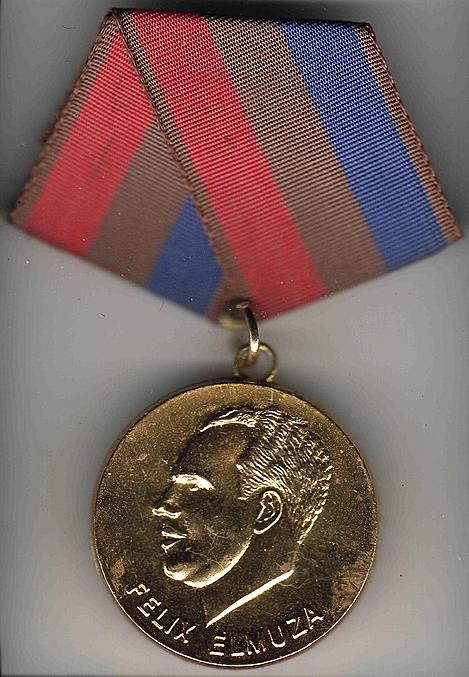 0
0 -
Awarded to Rebel Army combatants who as members of Column N?.8 ?Ciro Redondo?, commanded by Commander Ernesto Che Guevara, took part in the invasion from ?Las Mercedes?, in Sierra Maestra, to the former province territory of Las Villas, in 1958 and had maintained an exemplary and according attitude with the revolutionary principles.
Thanks again Vic http://www.cubalibre1959.narod.ru/
 0
0 -
Medalla "Ciro Redondo"
 0
0 -
Awarded to Cuban and foreign citizens, to recognize and to distinguish the accomplishment of high humanity or heroic content when giving health help or saving people whose lives are in extreme danger; or had distinguished themselves in activities, goals and purposes of the institution.
The Cuban Red Cross was founded by Diego Tamayo y Figueredo on the 10th March, 1909 and recognised by the International Committee of the Red Cross on the 7th September 1909.
In 1919 the Cruz Roja Cubana (CRC) joined the International Federation of Red Cross Societies.
The Cuban Red Cross maintains an overview of Cuba's medicines and medical supplies and distributes medical donations where they are most needed. Working to alleviate shortages caused by the US embargo, the Cuban Red Cross connects donors with hospitals and clinics around Cuba in order to distribute medical donations as quickly and efficiently as possible.
The Cuban Red Cross also responds to natural disasters in Cuba, helping to meet the needs of the Cuban population under extraordinary circumstances.
Interesting that Manuel ''Piti'' Fajardo is on this Red Cross medal, he fought alongside and was a Doctor with the rebel army.
At this point I would like to thank Vic for the kind use of his images. Here is a link to his site http://www.cubalibre1959.narod.ru/
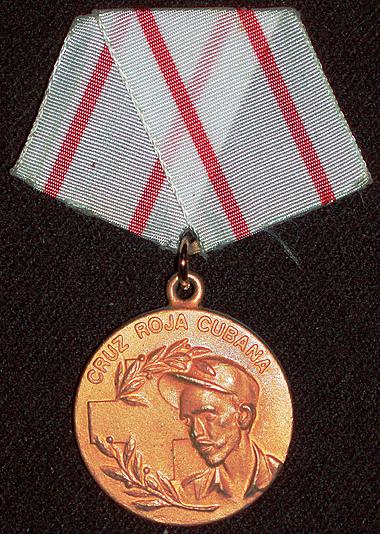 0
0 -
Medalla "Cruz Roja Cubana"
 0
0 -
Perhaps the snake is just artistic license. The Volunteers (represented by the wall) keep the bad guys (represented by the snake) out of the home country (represented by the sun's rays behind the wall).
Very possible Jeff,
I was unable to find a better description

http://www.onderscheidingen.nl/nl/publicat...stb1998_68.html
0 -
Vrijwilligersmedaille Openbare Orde en Veiligheid
Public order and security volunteer medal
Established by Royal Decree no. 288 of 14th June 1958 as a volunteer medal.
By ministerial decision of 2nd February 1998 (Bulletin of Acts, Orders and Decrees 68) this became legal and was provided with its current denomination.
The medal is granted to those, whose joint service or with a discontinuance of at the most two months during a period of ten years in repressive service tasks in the field of the public order and security have performed as a volunteer for:
-The police force;
- Overheidsbrandweer; (Fire Brigade)
- A brandweer (Fire service) of an institution as far as this brandweer fulfils tasks in pursuance of a regulation with the government for the overheidsbrandweer;
- The corps national Reserve (the military reserve);
- Organisations for life-saving from drowning;
- Ambulance service;
- The Dutch Red Cross;
- The national association for first aid, the royal Dutch association first aid or EHBO-Nederland;
- The volunteer corps of the Netherlands Antilles
The medal is manufactured from bronze and has a diameter of 35mm.
The front shows a wall with sunrays above. On the wall the words "PATRIAE SERVIRE LIBERTAS". At the bottom is a snake.
On the reverse the Dutch emblem is represented.
The medal is linked by means of a ring to the ribbon.
The ribbon is 33mm wide. The colour is green with orange stripes 1mm from the borders 2mm wide.
There is no clear definition of the colours green and orange.
There are two different colour ribbons described.
The first type was dark green with egg yolk orange edges. The Second, and current type, is poision green with dark orange edges.
For continuous service or with a discontinuance of at the most two months during a period of fifteen, twenty, twenty-five, thirty, thirty-five respectively forty years of performed service as a volunteer, a number in roman numerals is worn on the ribbon, of which the last received year attachment device is always worn.
I assume that the snake has a medical representational meaning as this medal is awarded to the Dutch ambulance service and Dutch Red Cross too.
Regards Eddie
0 -
Do you by the way know when this medal was established?
Sorry Kvart, no other details at the moment :(
0 -
Thank you so much for your answer, Taz.
But what is the different between this medal and The Service Medal of The Order of St. John? Apart from the 20 versus 12 years.
Hi Kwart,
Well, St. John Ambulance are a different and much older organisation.
Roots can be traced back to the 11th century.
In 1887 trained volunteers were organised into a uniformed Brigade to provide a first aid and ambulance service at public events. In many parts of Britain, St John was the first and only provider of an ambulance service right up to the middle of the 20th century, when the National Health Service was founded.
There isn't much on this award to be found on the web, however there is a book,
If you think it's worthwhile for you maybe you should concider buying one.
Title. Ambulance Service (Emergency Duties) Long Service and Good Conduct Medal
Great Britain Staff
ISBN 10: 010129042X / 0-10-129042-X
ISBN 13: 9780101290425
Publication Date: 1995
Regards Eddie
0 -
Not a great deal but it is awarded for 20 years service to paramedics and ambulance technicians.
Operational staff who reach their 20-year milestone with the Ambulance Service are awarded a Queen's Ambulance Service (Emergency Duties) Long Service & Good Conduct Medal provided they have completed 20 years' service, with at least seven years on A&E duties, and hold a clean disciplinary record.
0 -
BTW I will translate the most important parts if required as soon as I have more time.
Regards Eddie
0 -
Hi Taz, the document about post-unification wearing of ddr awards is very interesting ... I wonder if anyone has ever contested this 'ordre public' in relation to wearing specific DDR orden in court at any point? Cheers, Torsten.
Hi Torsten,
I found that article very interesting too, I haven't heard of any court cases with regards to wearing GDR awards in public.
In part it seems up to the descretion of the individual wether he wants to wear them or not.
The law leaves a lot of points still unclear in my opinion, of course that might have changed by now even though an update wasn't under concideration at the time of writing.
Regards Eddie
0 -
Verordnung ?ber das Tragen der Ehrenzeichen zu staatlichen Auszeichnungen vom 19. April 1978
Wearing of GDR awards in the unified Germany
0 -
Possible of course Rick,
I checked through my other Medals and bars and found the same with the Jesus Menendez Medal though.
Regards Eddie
0 -
A recent addition, showing the reverse
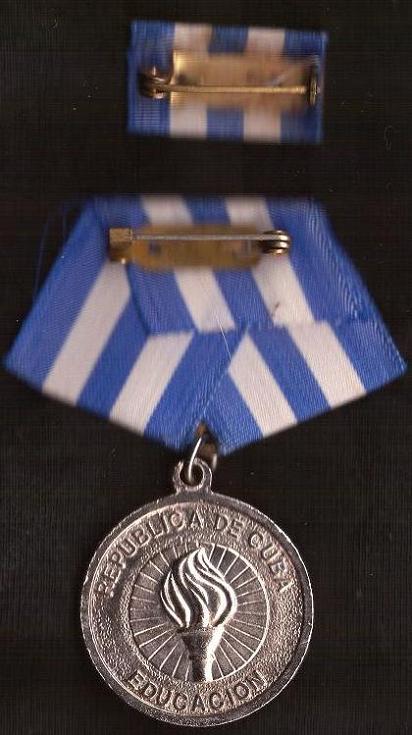 0
0 -
There is a book published on this subject that may interest you
A Guide to Military Temperance Medals
of the British Army and Royal Navy; by David A. Harris.
2nd Edition, many additions, 8 x 10", 128 Pages. Excellent reference
book for the medal collector. Ribbons in colour centrepages.
An indispensable Reference Guide for collectors & dealers.
0 -
hi, rick here is pick from my book
Translation of the book page with many thanks to Esteban.
The Commemorative medal "XX Anniversary" is given to every political, scientific or artistic figuer (individual) who, in a constant and diligent way had expressed his/her solidarity to our socialist revolution, as well as workers, armed forces members, students and common citizens who had participated in a significant way in international solidarity activities and to those who had accumulated exceptional merits with their participation on development and defense of our socialist homeland.
Regards Eddie
0 -
Excellent! Thanks!
I would think that all award booklets should bear the 26 July date then?
Hi Rick,
I would imagine that to be the case yes.
Regards Eddie
0 -
All of these Anniversario type Medals I have seen to date have had the metal suspension bars without a ribbon.
This particular one commemorates the 20th aniversary of the rather ill fated attack on the Moncada Barracks. The reverse shows the front of the building.
The date on which the attack took place, July 26, was adopted by Castro as the name for his revolutionary movement (Movimiento 26 Julio or M 26-7) and was chosen because it was the 100th anniversary of the birth of the Cuban writer and patriot Jose Mart?.
The Medalla Conmemorativa "XX Anniversario" is awarded by the Consejo de Ministros del Gobierno Revolucionario (Cabinet of the Revolutionary Government)
Attack on Moncada Barracks The Moncada Barracks was a military barracks in Santiago de Cuba, named after General Guillermon Moncada, a hero of the War of Independence.
On July 26, 1953, at 5:00AM, Fidel Castro and his brother Ra?l led a group of approximately 160 rebels in an attack on the second largest military garrison in Cuba, headquarters of the 400 (others say about 1,000) strong Antonio Maceo regiment, under the command of President Fulgencio Batista.
The night before the attack, 25 July, nearby Santiago de Cuba played host to a festival, and the rebel group believed the soldiers would be suffering from hangovers. Also, the rebels had stolen army uniforms to wear during the attack. The group formed an automobile caravan in order to give the appearance of being a delegation headed by a high-ranking officer sent from western Cuba. Their plan was to take the barracks, including the radio transmitter within it, and use it as a centre from which to broadcast propaganda to the Cuban people, with the ultimate hope of bringing down the Batista government.
The attack began poorly. The caravan of automobiles became separated by the time it arrived at the barracks, and the car carrying the guerillas' heavy weapons got lost. Furthermore, many of the rebels who would have taken part in the attack were left behind for a lack of weapons. The rebels also lost their possibility of surprise when Castro lost control of his car, crashed, and someone from the rebels opened fire to cover him. The net result of these events was the rebels being outnumbered more than 10 to 1.
Sixty-one rebels were killed in the fighting, and one third of them were captured. Half of the men captured were tortured to death. A handful of rebels, including Fidel Castro, escaped into the nearby countryside but were apprehended shortly thereafter.
After the attack the bullet holes and scars of battle were quickly covered up by the Batista regime.
After the revolution the barracks, now a school and a museum, had holes drilled in the walls to commemorate the battle.
At the Moncada barracks, an Act of Commemoration takes place early in the morning every year: the list of the martyrs of the revolution is read out
 0
0 -
Gesetzblatt der Deutschen Demokratischen Republik
Sonderdruck Nr. 952
Staatsverlag der Deutschen Demokratischen Republik, 1978
80 pages
With many interesting information about DDR awards!!

Under the link below the Verordnung ?ber das Tragen der Ehrenzeichen zu staatlichen Auszeichnungen vom 19. April 1978
F?r das Tragen der Ehrenzeichen zu staatlichen Auszeichnungen gem?? ?3 Abs. 5 des Gesetzes vom 7. April 1977 ?ber die Stiftung und Verleihung staatlicher Auszeichnungen (GBI. I Nr. 10 S. 106) wird folgendes verordnet....................................
Can be downloaded as a PDF file.
http://www.ddr-im-www.de/Gesetze/Verordnun...hrenzeichen.htm
Although in German I'm sure there are enough German speakers who are willing to help if it is needed.
Hope you find it interesting.
Best regards Eddie
0 -
On the Banner, I think anyone there could be awarded one as as far as I know any work was considered labor as far as the DDR state was concerned... even working in the military, border guards, etc. But if someone has other info please post for the benefit and interest of all that are intro'd.
Dan

Hi Dan,
Here is some info for you on the award critaria for the Banner der Arbeit
Award critaria
The Banner of Labour (Banner der Arbeit) was awarded for "outstanding achievements of many years which stabilized and strengthened the country, and in particular for high results of working in the national economy".
The order was established on August 4th, 1954 in one class.
On August 8th, 1974 it was divided into three classes. The 1st Class was the highest class and each class included a cash award:
- 1st Class: 1,000 East Marks, limited to 250 per year
- 2nd Class: 750 East Marks, limited to 500 per year
- 3rd Class: 500 East Marks, limited to 1,000 per year
The Banner of Labour was awarded to:
- Individuals and collectives in all three classes.
- Enterprises, Collective organizations (Kombinate), institutions and cooperatives in the 1st Class.
The awards ceremony took place each year on the 1st May and this order was presented by the Chairman of the State Council or on his behalf. A certificate was presented with the Order.
The medal is gilded, with dimensions of 44 x 37 mm. It is worn on the left chest. Establishments were entitled to include symbol of the Order on their flag as well as on documents.
Regards Eddie
0 -
Normal suspension type.
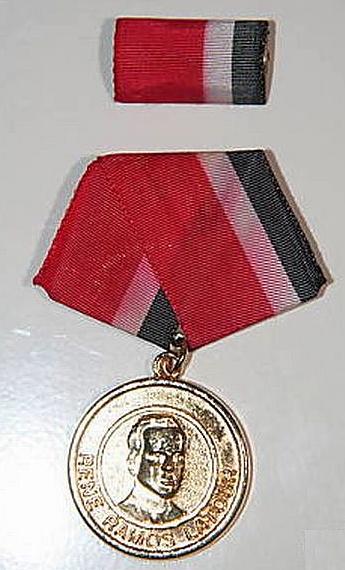
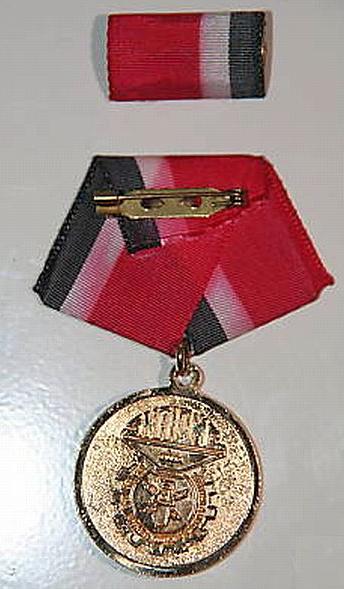 0
0 -
I tried to email the guy who wrote that and for some reason my email wasn't sent, my mail won't accept the address i'm trying to send to.
Maybe someone else can try?
All I found is that they were involved in the War of Independance.
Regards Eddie
0 -
What is the thing behind the torpedo and above the electric rays?

A Mine?
0




Distinci?n "F?lix Elmuza"
in Republic of Cuba
Posted
reverse